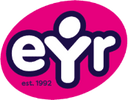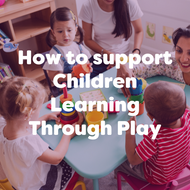How to support Children Learning Through Play
Posted by EYR Team on 20th May 2020
read more
This article has been written by early years consultant, Anne Rodgers from ATR Consultancy, who explains the different ways children learn through play and shares tips for how you can support them.
Children have different ways in which they learn. By recognising their individual learning styles, we can help them to develop. There are 4 different types of learning styles which we will delve into in more detail in this blog:
- Visual
- Kinaesthetic
- Auditory
- Logical
1. Visual Learners
Visual learners learn through seeing. They may like to sit at the front of the classroom at story time so they can get the best view of the story, because they need to see the adult’s body language and facial expressions to understand what they are asking of them. Use of visual displays helps children with learning and remembering, as well as illustrated books and picture association such as a visual timetable.
Some children may:
- Need, and like, to visualise things
- Learn through images and can remember the picture on a page
- Enjoy creating art and drawing
- Be interested in machines and inventions, or scientific activities
- Play with construction toys such as duplo, and like jigsaw puzzles
- Be a daydreamer
How to encourage visual learners:
- Use board games and memory games to create visual patterns.
- Suggest vital clues when reading together – let the child ‘paint’ their own imagined pictures as they read the story.
- Offer picture books of all types.
- Encourage visualisation of stories, and reinforce this at intervals.
- Encourage writing through using different colours of writing.
- Teach mind mapping techniques to older children, to help them learn and recall complex information.
- Show videos to reinforce the stories you are reading, or use the internet to discover visual cues.
- Using displays, charts and mobiles in the room will give children visual cues to topics and increase learning objectives.
- In the outdoor environment, use windsocks, windmills, mobiles and bunting as a focus to look at. Using outdoor displays is a good way for children to learn about their environment.
2. Kinaesthetic Learners
Kinaesthetic learners learn through moving, doing and touching. They are tactile and learn best through a hands-on approach. By actively exploring activities and experiences they will fully learn about the world around them. They may find it hard to sit still for long periods and may become distracted easily.
Some children may:
- Process knowledge through physical sensations
- Be highly active, and not able to sit still long
- Communicate using body language and gestures
- Show you rather than tell you
- Want to touch and feel the world around them
- Be good at mimicking others
- Enjoy sports and other activities where they can keep moving
How to encourage kinaesthetic learners:
- Physical activity and movement will help them to focus better. Give them something to hold at story time so they can fidget with it rather than annoy others.
- Use hands-on activities and experiments, art projects and nature walks or act out stories so they ‘feel’ the activities.
- Encourage messy play and sensory experiences within their planning needs. Allow for expressive movement and dance and scientific experiments that are hands-on. Messy play, sensory play, building blocks and role play will help them to develop also.
3. Auditory Learners
Auditory learners learn through listening, talking things through and hearing what others have to say. They pay attention to tone and pitch of voices and benefit from being read aloud to or instructed to do something.
Some children may:
- Think in words and verbalise concepts
- Tend to learn phonetically rather than through ‘look and say’ techniques
- Be a good reader, though some prefer the spoken word
- Have excellent memory for names, dates and trivia
- Like word games
- Enjoy using tape recorders and are often musically talented
- Have the ability to learn their times table with relative ease
How to encourage auditory learners:
- Ask them to dictate a story to you and watch while you write or type it out.
- Read aloud together and tape the session so that you can play it back later.
- Buy or borrow audio books on tape for them to listen to.
- Find books and stories that are interesting to listen to and which have lots of ‘parts’ to play and use different ‘voices’ for the characters.
4. Logical Learners
Logical learners like to explore patterns and relationships between objects.
Some children may:
- Enjoy puzzles and seeing how things work
- Consistently question and wonder
- Like routine and consistency
- Be capable of highly abstract forms of logical thinking at an early age
- Easily do mental arithmetic
- Enjoy games, computers and experiments with a purpose
- Create their own designs to build with blocks or duplo
- Not be so good at the more ‘creative’ side of activities
How to encourage logical learners:
- Do science experiments together and get the children to record the results. Play with puzzles, sorting games and mathematical activities.
- Use computer learning games and word puzzles.
- Introduce non-fiction rhyming books or rhyming games.
- Ask them to help with cooking activities using sequence cards for a recipe to show them what comes next.
The role of the adult
Adults need to support and encourage all children to enable them to gain in confidence and try new things. They need to be available to explore with them and talk about things that interest young children indoors and outside, and listen and respond to their questions. Children need to be supervised at all times indoors and outdoors, yet allowed freedom to take risks and manage their own play.
It is important that children have plenty of time, both indoors and outside, every day to play and experiment and it is essential that the adults share in the child’s curiosities and delights. The adult needs to be tuned in to the children and their interests, and teach children how to care for the resources by modelling good practice.
Planning for play
Planning for the curriculum and next steps in development will help adults to know what it is that the children need to learn next, but also how to extend their play ideas and to have fun exploring and experimenting. Adults need to observe how play is being managed and change areas if necessary to meet the needs and interest of the children.
By looking at the continuous provision of a setting, think about how these can be more available to children’s learning styles.
For example:
Planning for Play with Sand
Visual Learners: Try using different coloured sand, moulds, sand timers, glitter, and hiding objects in the sand for children to discover.
Kinaesthetic Learners: Use wet and dry sand, sandpaper, numerals and letters, and mark making tools.
Auditory Learners: Try playing sounds of the ocean by the sand tray to encourage imaginative play, and make sand shakers.
Logical Learners: Rake sand and use items such as scrapers to make patterns with, as well as using moulds and containers to construct with.
Observation of children will help practitioners discover the child’s likes and dislikes and ways in which they learn so that opportunities can be incorporated into planning for next steps.
Adults need to ensure that children have opportunities to learn and play freely with resources, attempt independence and make choices and suggestions about ‘what comes next’. Ensuring children are engaged with their activities and experiences will help them to learn and develop towards their individual next steps.
About Anne Rodgers
Anne Rodgers is an Early Years Consultant (ATR Consultancy) and Writer. Anne has 36 years’ experience of working in the childcare and education sector – including training practitioners, managing numerous settings over the years and writing articles for Early Years Educator and the CACHE Alumni website.






